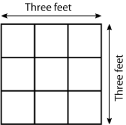One of the most surprising things about units of volume may be the relationship between different units of volume. For example, consider the number of cubic feet in a cubic yard. Because you are probably quite familiar with the fact that there are 3 feet in a yard, you would perhaps be surprised to learn that there are 27 cubic feet in a single cubic yard! How could this be? Consider the number of square feet in a square yard. A square that is a yard on a side is 3 feet long by 3 feet wide. 3 x 3 = 9, so there are 9 square feet in a square yard. Now, if each one of these square feet were to become 1 foot thick, they would be transformed into cubic feet. These 9 cubic feet would fill a region 3 feet wide by 3 feet long by 1 foot thick. We would have to have three layers exactly like this one to fill a cubic yard. 9 cubic feet in a layer, times three layers, is 27 cubic feet in a cubic yard. What about the number of cubic inches in a cubic yard? Do you have a guess? Would you believe that there are over 46,000 cubic inches in a cubic yard?!
 |
In the metric system there is an interesting relationship between the units used for linear measurement and units used for measurement of volume. The liter, the basic unit of volume, is defined as a cubic decimeter (a cube 10 cm by 10 cm by 10 cm). The 10-to-1 relationship is again built into the system by design, making conversions a simple matter of multiplying or dividing by powers of ten.
The relationship between volume and weight, and a difficulty caused by this relationship, is well known to bakers and cooks. Butter and margarine are sold in units of weight (pounds). The sticks inside those pound packages are quarter-pounds. However, recipes almost always call for volume-units of butter or margarine. A typical recipe will call for 1⁄2cup of butter, even though the butter is packaged in quarter-pounds and pounds. An experienced cook knows that cup of butter is the same as pound (one stick) of butter. It is only through repeated exposure that an experienced cook becomes skilled with this conversion. There is no readily available conversion formula, and the conversion is not one that we learn in school. Because the conversion is so unusual, the butter manufacturers place markings on the quarter-pound wrappers that designate tablespoons, quarter-cups, and cups, which are volume measurements.
![]() Further enhance your math curriculum with more Professional Development Resources for Teaching Measurement, Grades K-5.
Further enhance your math curriculum with more Professional Development Resources for Teaching Measurement, Grades K-5.










